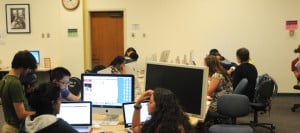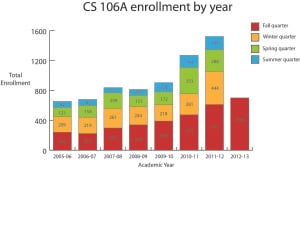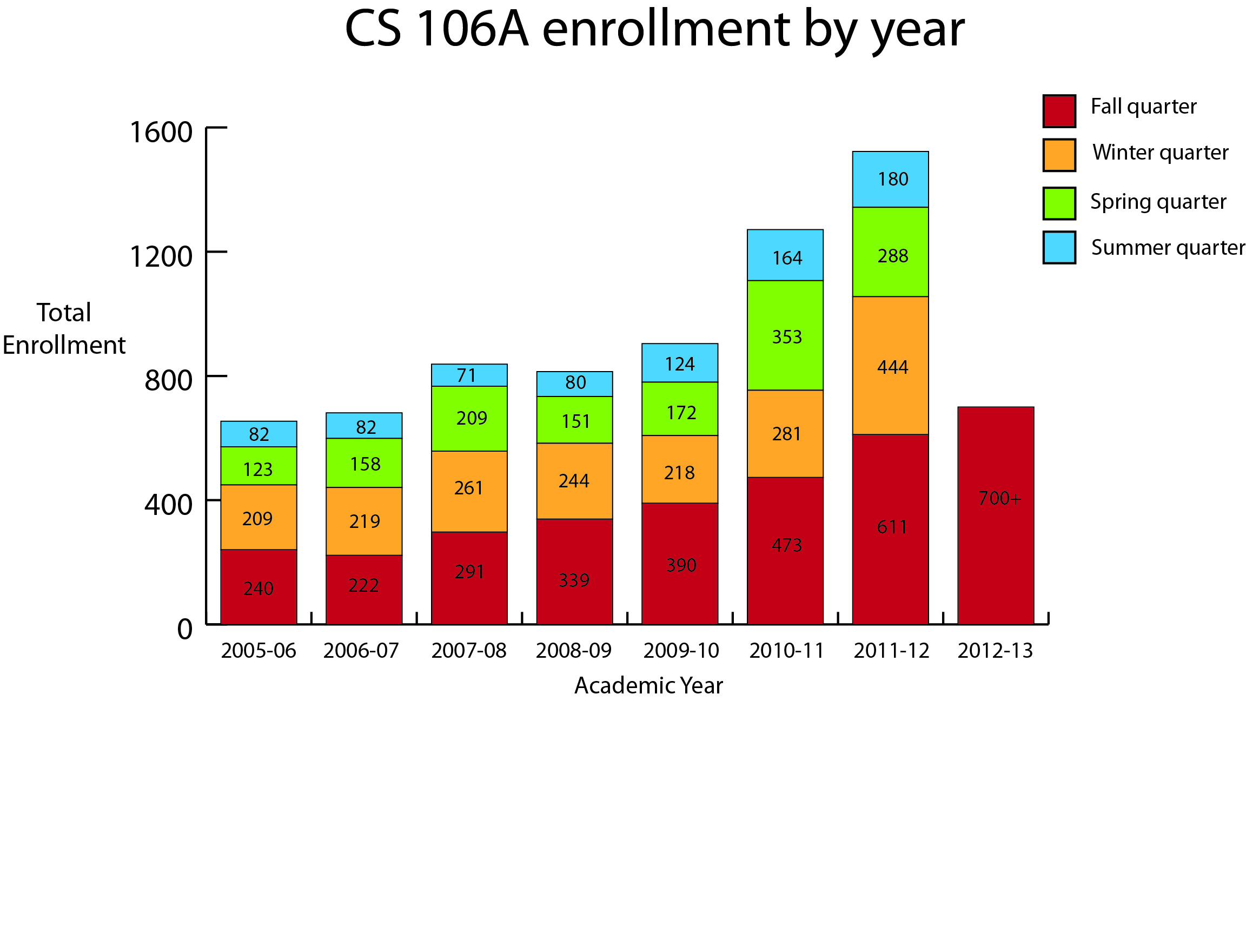The second-largest classroom on campus, Hewlett 200, is no longer large enough to hold the 700-plus students enrolled in CS106A this quarter. Representatives from the Stanford University Fire Marshal’s Office visited Wednesday’s lecture in the 498-person capacity room.

CS106A, Stanford’s computer science department’s introductory course, has experienced a steady increase in enrollment numbers over the past five years.
“Back in the 2007-2008 school year, the enrollment for the class in fall quarter was around 300 students,” said Mehran Sahami B.S. ’92 M.S. ’93 Ph.D. ’99, associate professor of computer science and fall CS106A instructor. “Then it went from 300 to 400 to 500 to 650, and this quarter we broke 700.”
While Cemex Auditorium, which seats 595 people, is larger than Hewlett 200, Sahami prefers the latter because it “is the biggest classroom that is really equipped for teaching.”
The Registrar’s office capped enrollment for the first time in the course’s history this year. The cap was set at 502 students, but because it was placed after most students had already enrolled, there continues to be many students over the enrollment cap.
The CS106A teaching staff had not planned on videotaping lectures this quarter, but the large enrollment numbers forced their hands.
“We hope that alleviates the physical presence in the lecture hall enough that the registrar lifts the enrollment cap,” Sahami said.
Filming started on Sept. 28, and Sahami said that while most aspects of his lectures translate fairly well to video, the medium does have some drawbacks.
“I think the opportunity to come to class and engage and ask questions makes for a more lively experience,” Sahami said.
To explain the enormous popularity of CS106A, Keith Schwarz B.S. ’10 M.S. ’11, a lecturer in computer science who teaches CS106A in the winter, argues that a number of reasons draw large numbers of students to the class, the most notable being Stanford’s links to Silicon Valley.
“There are a lot of people who are coming into computer science because they are looking at the opportunity to make a lot of money and [are] saying, this is, financially, a very reasonable call to make,” Schwarz said.
In addition to the economic incentive, Schwarz said that the tools students learn in CS106A can be very empowering.
“With computer science, you can come in and in just a few weeks, you could be making something that has never been made before in the history of the world and that is a very cool idea,” Schwarz said.
The applicability of computer programming skills to a variety of fields also draws students from different academic backgrounds, according to Sahami.
“The curriculum in the 106 series is made so it is accessible for everyone. You don’t have to be a computer science major or even an engineer to take the class,” Sahami said.
According to Sahami, an equal number of students enrolled in CS106A go on to major in the humanities as go on to major in computer science. Of CS106A students, about 10 percent will major in computer science. Schwarz estimated that students from 45 to 50 different majors took his CS106A class last winter.
Of students who enter the class with no computer science background, some discover their passion for programming by taking introductory classes like CS106A.
“There are a lot of students who choose to go on in computer science or a related fields as a result of 106A just because they realize everything they can do with [a knowledge of programming],” Sahami said.
Stephanie Nicholson ’13, a computer science minor and section leader for CS106A, said that it was CS106A that sparked her interest in programming.
“I really liked how you can build something new and creative…You actually produce a product that you can interact with,” Nicholson said.
“I think at Stanford there’s pressure to take at least one CS class before graduating,” said Raymond Luong ’15, who took CS106A in the fall of 2011. “People also see it as a useful class in terms of improving their resume by saying that they know Java.”
Schwarz posed one more theory as to why CS106A is so popular–the educational programming tool beginner computer science students use.
“Karel the Robot is awesome. Who doesn’t love Karel the Robot?”

*CS106A is cross-listed as ENGR70. Numbers include both listings.
*Fall 2012 actual enrollment higher than register cap.
*Data from the Office of the University Registrar
